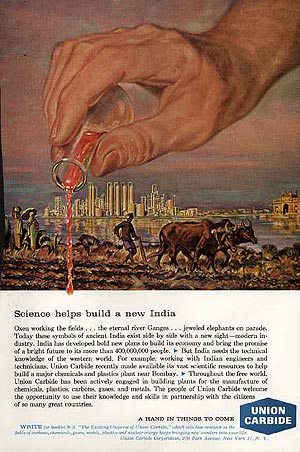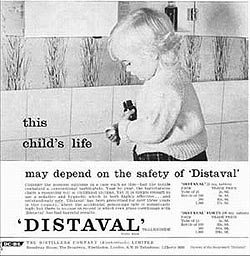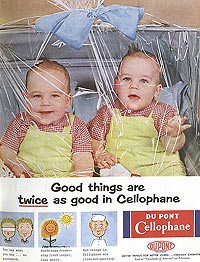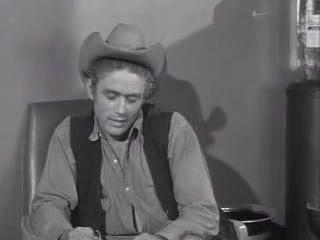Top 10 Ironic Ads From History
Remember when you could buy barbiturates for the baby? Cover your house with asbestos? Or get heroin from the doctor? Okay, probably not, but thanks to the immortal beauty of advertising, you can take a trip back in time. Here’s our pick of some of the most ironic ads in American history.
 UNION CARBIDE
UNION CARBIDE
“Science helps build a new India”
Ah, the innocent days before a Union Carbide plant in India obliterated everyone in sight. In 1984, Union Carbide’s plant in Bhopal released 42 tons of toxic gas into the air, ultimately killing about 25,000 people. The stench of this “new India” remains to date, in fact, as the Yes Men have duly pointed out.
(Image via Copyranter)
CORVAIR (1960)
The Corvair in action!
Impaling drivers with steering wheels!
Leaking oil!
Spiraling out of control!
You may remember the Corvair as the focus of Ralph Nader’s classic book Unsafe at Any Speed. (This, before Nader had grown senile and was busy saving the country from itself.) If your family had a Corvair and didn’t die in it, please be sure to go on about that in comments because that disproves everything. Considered one of TIME’s 50 Worst Cars of All Time.
ASBESTOS (1981)
“When life depends on it, you use asbestos”
Okay, sure, when you need to get out of a burning building fast, asbestos may give you a few extra minutes. But you better be wearing a respirator because when that fucker collapses, that asbestos is getting in your lungs, where it will fester for years before killing you mercilessly. (Wait, did we mention 9/11?)
(Image via Copyranter)
 DISTAVAL (Thalidomide), circa 1960
DISTAVAL (Thalidomide), circa 1960
“This child’s life may depend on the safety of Distaval”
Who says advertising doesn’t tell the truth? Sadly, this slogan was more true than anyone expected at the time. Distaval was a brand name for thalidomide, a drug that causes serious birth defects. Think flipper babies and death. This sedative-hypnotic, commonly prescribed to stressed-out moms, was advertised as “especially suitable for infants” as well. (On a side note, am I sick for longing for the days when it was okay to sedate your baby?)
(Image via Bonkers Institute)
 DuPONT’S CELLOPHANE BABIES
DuPONT’S CELLOPHANE BABIES
Parents who tired of drugging their babies could always turn to cellophane to keep them quiet. Permanently quiet, in fact. In 1959, Life and other media sources scared readers with “the latest household peril” — plastic dry cleaning bags — so we’re betting this ad dates prior to that.
(Image via Copyranter)
DUTCH BOY LEAD PAINT
“Where your dream house comes true, don’t let cheap paint make it a nightmare!”
You want to hear my nightmare? How about spending nearly a year stripping lead paint in my dream home, wearing a gas mask and gloves and keeping the bedroom in lockdown so that toxic dust and muck doesn’t spread everywhere?
 BAYER HEROIN
BAYER HEROIN
Not only did Bayer once own the trademark on Heroin, it promoted it to doctors as a non-addictive substitute for morphine. For a while, doctors took the bait. “It possesses many advantages over morphine,” wrote the Boston Medical and Surgical Journal in 1900. “It’s not hypnotic, and there’s no danger of acquiring a habit.” The American Medical Association approved the use of heroin in 1906, but by then the “junkies” foraging scrap metal to feed their habit were getting hard to avoid. Bayer stopped making heroin in 1913 when prohibition seemed inevitable, and its use without a prescription was banned in the US the following year.
How Aspirin Turned Hero [Sunday Times, September 13, 1998]
JAMES DEAN’S “SAFE DRIVING” PSA
When it first released Rebel Without A Cause, Warner Brothers was concerned that kids would ape James Dean’s character and wind up driving off cliffs. (A problem, of course, because the kids’ relatives would likely sue the company.) To distance themselves from copycat incidents preemptively, Warner Brothers had Dean film this public service announcement urging kids to “Take it easy driving out there. The life you save might be mine.” Alas, the clip was never used because Mr. Dean was killed in his speeding Porsche shortly before the movie was released.
As predicted, a number of teens copied Dean’s “chicken” game and died while racing over cliffs. (Boston Globe, October 20, 1993)
THE FORD PINTO
“The little carefree car”
Carefree? Hardly. Ford’s Pinto was designed in such a way that rear-end collisions could cause the car to catch fire and blow up. An internal memo revealed that Ford execs were well aware of the problem, but determined not to fix it. Why? Ford’s cost-benefit analysis showed that paying off potential law suits from deaths was cheaper than a redesign. Another one of the TIME’s 50 Worst Cars.
CAMELS
“More doctors smoke Camels…”
Ironic old cigarette ads are a dime a dozen but we figured we should include at least one, if for no reason than to call this post an even 10.
That’s all. Thanks.
Carrie McLaren & Jason Torchinsky are coeditors of Ad Nauseam: A Survivor’s Guide to American Consumer Culture. In previous lives, they worked together on the hopelessly obscure and now defunct Stay Free! magazine .
Want more consumer news? Visit our parent organization, Consumer Reports, for the latest on scams, recalls, and other consumer issues.


 JAMES DEAN’S “SAFE DRIVING” PSA
JAMES DEAN’S “SAFE DRIVING” PSA